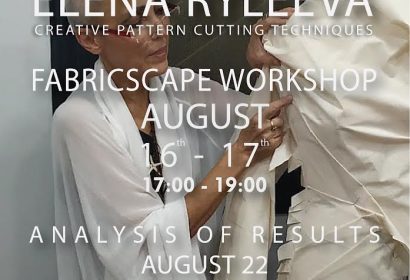With the support of RECONOMY and the Ria Keburia Foundation in the direction of “Fashion Design”, an educational and creative project will be organized at the “Kachreti Ambassador” exhibition space from November 24 to December 1, 2024: “Design Lab – Intertextual Synergy in Design”.
Project Leader:
Nino Mgaloblishvili, Professor, Doctor of Cultural Studies
Within the framework of the project, a program was specially created for students of the Fashion Design Program (MA) at the Tbilisi State University of Fine Arts (TSSA) and Ukrainian guests. The program included a practical course titled “Natural Plant Dyeing Technologies and Experimental Design (T&M)” and a presentation of the results.
Purpose of the Course:
• To deepen knowledge about design sustainability and eco-stability for the development of participants’ creative careers.
• Study of eco-technologies based on natural materials.
• Fabric decoration with natural dyes using an experimental method.
• Methods of painting and processing fabric surfaces with living plants.
• Development of experimental design skills, group, and individual activities of participants.
Experts of Practical Sessions:
• Eka Chkhutishvili, Associate Professor
• Maryam Beridze, Associate Professor
• Lela Kirtadze, GTG – Georgian Textile Group member
Participating Audience:
TSSA Fashion Design MA Program students:
• Eva Gogotidze
• Elene Betlemishvili
• Elene Turashvili
• Tamar Zaloshvili
• Mariam Kvavadze
• Mariam Djibuti
• Nao Aslamazashvili
• Salome Tsivtsivadze
Specially invited guests from Ukraine. https://shorturl.at/JCtUr
Project Results:
• Fabrics painted with natural plants – unique works of art based on sustainability principles.
• Design objects created using experimental methods and lossless pattern techniques, employing non-traditional sewing technologies as per the practical methods of world-renowned experts in sustainable fashion and textiles.
Featured Experts:
• Shingo Sato – Founder of TR Cutting School, Professor
• Julian Roberts – Founder of Subtraction Cutting, Professor at the University of Portsmouth, Trustee of the Graduate Fashion Foundation (GFF/GFW) in the UK
• Elena Releeva / Elena EWEST – Founder of the international organization “EWST fashionlab”
Tutor:
Leila Enukidze, TSSA Visiting Teacher
– https://shorturl.at/scWnd
– https://shorturl.at/3nzfR
– https://tinyurl.com/d4jbfzrf
– https://tinyurl.com/3tj552uv
– https://tinyurl.com/mr4xp3pb
– https://tinyurl.com/4me84jkz
– https://shorturl.at/3bChH
– https://tinyurl.com/4e2jsntb
– https://tinyurl.com/4u2u9wjs
– https://tinyurl.com/86jk9vnt
Dates:
September 24 to September 28, 2024
Location:
Kachreti, Ria Keburia Foundation Exhibition Space
Project Supporters:
• RECONOMY
• TSSA/Fashion Design Portal
• Initiative NK
• Ria Keburia Foundation/Art Residence/Ambassador “Kachreti”
16. Educational-Creative Project “Design Lab – Intertextual Synergy in Design”
With the support of RECONOMY, the educational-creative project “Design Lab – Intertextual Synergy in Design” has been organized in the direction of “Fashion Design”.
Project Leader:
Nino Mgaloblishvili, Professor, Doctor of Cultural Studies
Within the framework of the project, Shadi Mohamed Hassan, the leader of the Global Pleating team at the world-famous pleated fabric and cardboard manufacturing company Al Alamia Plisse, was specially invited.
Al Alamia Plisse was founded in 1981 in Alexandria, Egypt. The company’s trademark “Global Pleating” is a family-owned business and is considered one of the world’s leading companies in the production of personalized designs for pleated fabrics and cardboard. Global Pleating provides services in more than 25 countries around the world.
Main Topics of the Practice (implemented for the first time in Georgia – taking into account the requirements of the global T&A (Textile & Apparel) industry):
1. Fabric design with folding and origami techniques – innovation in clothing design
2. Pleated fabric technologies and creation of personalized cardboard designs
3. Molds and folded fabric models (work on samples)
4. Fabric cutting methods, identification of material types, and processing technologies
5. Experimentation in the direction of placing fabric in various forms and thermal treatment (simulation of industrial folding)
6. Design combinations and practical applications inspired by the art of origami
7. Practical training in mold making
Dates:
From January 22 to January 27, 2025
Location:
22 Griboedov St., Floor VI, Room 606
Project Supporters:
• RECONOMY
• TSSA/Fashion Design Portal
• Initiative NK
• LEPL Tbilisi Apollon Kutateladze State Academy of Arts

